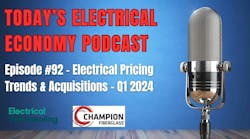With nearly 100 survey returns with 2014 sales forecasts already in at press-time for Electrical Wholesaling’s annual Top 200, the magazine’s editors are getting a pretty good sense of what electrical distributors see for the electrical wholesaling industry’s economic fortunes this year. When averaged together, these early returns show a 6.7% increase nationally in industry sales, which is squarely in the middle of the industry’s historical growth range of 4% to 8%.
Pockets of double-digit growth. Things get even more interesting when you analyze the data in the early returns from the 25 companies expecting a 2014 sales increase of 10% or better (a surprising 26% of total respondents). It’s not surprising the oil and gas market is lifting sales for some electrical distributors servicing the Texas and Bakken oil and gas business, and at least four of the companies that provided details on their 2014 growth forecasts attributed some of that growth to the energy markets — Border States Electric, Fargo, N.D. (+10.8%); Elliott Electric Supply, Nacogdoches, Texas (+15%); FirstSource Electrical, Houston (+13.5%); Mid-Coast Electric Supply Inc. (+15%); and Sun Valley/Energy Electrical Distribution, Las Vegas, Nev. (+20%).
But some Top 200 distributors from areas of the country where nonresidential construction and in some cases residential construction has recovered from the recession much faster than in other regions, like the Washington, D.C. suburbs, Silicon Valley and the San Francisco-Oakland Bay Area or Boston metropolitan area, attribute their double-digit growth forecast for 2014 to a healthy construction market. These electrical distributors include Bell Electrical Supply, Santa Clara, Calif. (+10%); Forest Hills Electrical Supply, Randolph, Mass. (+25); Dulles Electric Supply Corp. (+20%); Granite City Electric Supply, Quincy, Mass. (+15%); and Independent Electric Supply, Somerville, Mass. (+10%).
Bell Electrical Supply’s Burt Schraga said Silicon Valley is “on fire,” and that small and medium electrical contractors are very busy, while across the country John Milotte, general manager, Dulles Electric Supply Corp., said in the Washington, D.C., metropolitan area, “Commercial construction growth is very strong followed by a reasonable increase in residential construction with a stagnant government sales market.”
LED opportunities. When you dig into the individual product markets with the most action, challenges and future potential, the LED lighting market has clearly captured the attention of not only the lighting design professionals who have seen its potential over the past decade, but also the Top 200 business owners who have to figure out a way to make a profit selling LED technology.
Judging from the early returns to Electrical Wholesaling’s Top 200 surveys, LED lighting has already clearly changed how electrical distributors approach the lighting market, but wholesalers are finding they must manage challenges like customers who got burned by purchasing inferior LEDs from unknown offshore suppliers in their first experiences; servicing or backing a five- or 10-year warranty in a product where product obsolesce is such a big factor; and selling a product that won’t have to be replaced for a decade, which potentially eliminates much of the lamp replacement business that historically drove sales in the lighting market.
Michael Fromm, CEO, Fromm Electric Supply, Reading, Pa., says LEDs now represent almost 20% of his company’s lamp business, and that they are also selling a lot of fixtures with on-board LEDs. The biggest challenge for Fromm Electric in this market? “Knowing we may never sell another lamp again for the same LED application,” he says.
Philip deLoache, First Source Electrical’s president, said LED lighting is becoming the preferred lighting technology for many customers as prices have fallen and the economics have improved. “We stock and sell a wide range of LED lighting products both indoor and outdoor and expect to see this in incandescent and most HID light sources,” he said. “The challenges have been the lack of standards and the many low-quality products consumers cannot differentiate from high- quality, name-brand LED products. Until recently the price points have also been so high LED lighting would put a project out of budget.”
Facility Solutions Group, a hybrid distributor that has both electrical supply and ESCO businesses, was all-in early on LEDs and may have had more experience with them than any other electrical distributor. William Graham, CEO of the Austin Texas-based company, believes LED lighting is mirroring the personal computer revolution of the late 1980s and early 1990s, and he expects the technology will continually get better. “It will be embraced by every segment in the market,” he says. “It will be the hardware of lighting that will also usher in a demand for software (control, management, application) support. It’s here to stay.”
When asked about the biggest challenges Facility Solutions Group has had with LEDs, Graham listed several concerns in his survey response, “Low cost of entry into the market by too many non-lighting competitors… Internet visibility of options and price points on products sucks value out of the selling process. Rapid generational obsolescence of products... The rapid rate of performance improvement and decline in cost leaves manufacturers and distributors holding dollars of product that is no longer relevant. Overstated performance claims... Inconsistent standards... Complex technology.”
Competition from AmazonSupply. Electrical Wholesaling also asked Top 200 survey respondents about the chances of AmazonSupply taking significant market share away from electrical distributors and their responses were mixed. While some executives said AmazonSupply is or will be a big threat to their business, generally speaking, most of the respondents who commented said that while Amazon Supply will take some market share, customers will still go first to distributors of electrical supplies for their purchases.
Rick Kerman, CEO, Steiner Electric Co., Elk Grove Village, Ill., is not taking AmazonSupply lightly. “They are a significant concern,” he says. “We are hopeful the top suppliers realize Amazon does not spec product, (and) only sells it when requested. Distributors provide all the product knowledge, local inventory, technical support and after-hour services and delivery that is more costly and much more valuable to the supplier/distributor relationship. We hope the supplier continues to hold this in high regard.”
Other Top 200 electrical distributors think AmazonSupply may be a tough competitor for commodity items or for distributors that don’t offer a full package of value-added services that their customers want, but that they won’t be much of a factor in switchgear, lighting packages, wire and cable or highly engineered project business. Said Fromm Electric Supply’s Michael Fromm, “Amazon’s fulfillment and pricing models will be a challenge for distributors in all industry segments. In electrical, they may capture commodity business, but complex automation or lighting and control systems design will be difficult.”
Rock Kuchenmeister, president, K/E Electric Supply, Mt. Clemens, Mich., said some of his company’s facilities management and MRO customers are price shopping at Amazon Supply, but they still come back to his company and other electrical distributors to order. “Essentially, the customer searches the internet for products and pricing, instead of seeking information from sales reps,” he said. “Some of these customers are comfortable ordering from the internet sites, others just want the distributor to match the price.”










